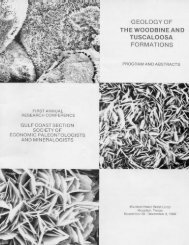Petroleum Systems of Deep-Water Basins - Gulf Coast Section SEPM
Petroleum Systems of Deep-Water Basins - Gulf Coast Section SEPM
Petroleum Systems of Deep-Water Basins - Gulf Coast Section SEPM
Create successful ePaper yourself
Turn your PDF publications into a flip-book with our unique Google optimized e-Paper software.
<strong>Petroleum</strong> <strong>Systems</strong> <strong>of</strong> the <strong>Deep</strong> <strong>Water</strong> Scotian Salt<br />
Province, Offshore Nova Scotia, Canada<br />
John R. Hogg<br />
john_hogg@pancanadian.ca<br />
David A. Dolph<br />
David Mackidd<br />
Karin Michel<br />
Pan Canadian Energy Corporation<br />
150 9 th Avenue, S.W.<br />
Calgary, Alberta T2P 2S5<br />
Abstract<br />
The Scotian Basin, under Atlantic Canada’s continental shelf and slope, encompasses a corridor 100 to 150 km<br />
wide by 900 km long on the southeastern continental slope <strong>of</strong> the province <strong>of</strong> Nova Scotia, Canada. Since 1967, a<br />
total <strong>of</strong> 103 exploration wells have been drilled in the shelf portion <strong>of</strong> the basin within the setting <strong>of</strong> the Sable<br />
subbasin.<br />
The Scotian Basin is divided into a series <strong>of</strong> geologically distinct subbasins. Opening occurred during the Middle<br />
to Late Triassic, in response to separation <strong>of</strong> North America from Africa. During this time, synrift red beds, restricted<br />
marine dolomites and halites <strong>of</strong> the Eurydice, Iroquois and Argo formations, respectively, have been deposited. From<br />
the Early Jurassic to the end <strong>of</strong> the Cretaceous, the basin continues to subside, infilling with significant quantities <strong>of</strong><br />
fluvio-deltaic and shelf sandstones. During lowstands, incision <strong>of</strong> the shelf carries sands down the paleoslope into<br />
deep marine environments, where they are deposited within a variety <strong>of</strong> subaqueous facies. The Tertiary-aged Banquereau<br />
Formation consists <strong>of</strong> fluvial, deltaic, and deep water sandstone environments.<br />
Although tectonically passive, deep water portions <strong>of</strong> the Scotian Basin contain the Scotian salt province. This<br />
subbasin is extensively deformed by halokinetic movement <strong>of</strong> Late Triassic Argo Formation halite, which mobilized<br />
to form swells, walls, ridges, and domes. Sedimentation and play-types vary considerably along the 900 km <strong>of</strong> the salt<br />
province within water depths <strong>of</strong> 1,000 to 3,000 metres with the potential for a number <strong>of</strong> distinct petroleum systems<br />
throughout the subbasins and include potential subsalt exploration targets.<br />
2

















